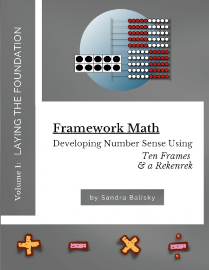Framework Math: Developing Number Sense Using Ten Frames & a Rekenrek is a series of five books, with an additional “condensed” option for the first book. Framework Math supplements your core math program by helping students develop a deeper conceptual understanding of addition, subtraction, multiplication, and division.
The five volumes work sequentially as is evidenced by their titles:
- Volume 1 – Laying the Foundation
- Volume 2 – Addition: Sums from 1 to 1 Million
- Volume 3 – Subtraction: Single-Digit to Multi-Digit
- Volume 4 – Multiplication: Single-Digit to Multi-Digit
- Volume 5 – Division: From the Single-Digit Facts through Long Division
Each lesson follows a consistent progression beginning with concrete, then shifting to pictorial, and finally to abstract. The concrete aspect is accomplished primarily using ten frames and a rekenrek (a type of abacus), although some books also use coins, a deck of playing cards, and dice. Multiplication includes the use of a hundred chart and grids, and various grids are also used for division. The books include ten frame templates and many types of grids, but you will need to purchase a rekenrek with 100 beads of two different colors.
Ten frames and the rekenrek are both used on their own within some other math programs, especially in kindergarten and the primary grades. But Framework Math uses both types of manipulatives through instruction in long division to demonstrate two different ways of visualizing math facts and solving problems.
Students learn strategies for solving problems that differ from those normally taught. One of the most frequently used strategies is learning to visualize math facts with manipulatives rather than memorizing them. They look for groups of five or ten, then decide how many more or fewer beads (on the rekenrek) or circles (on ten frames) there are in relation to the group of five or ten. The physical manipulatives, images in the books, and flashcards help students develop the ability to immediately recognize numbers from these visual images, a skill called subitizing. Students adapt and expand this skill as they learn about place value and move on to larger numbers.
The books include reviews, word problems, games, and problems that require critical thinking or mental math. At the back of each book are templates, flashcards, and other resources to be used with the lessons.
The strategies will work better for some students than for others, and you might find that a child needs to use the manipulatives for addition and subtraction but no longer needs them for multiplication and division. You can use as many volumes as you find helpful.
There are no grade levels associated with any of the books, and you can start with children as young as kindergarten. No matter the age of the student, the author says to move at the student’s pace, working toward mastery of each skill before moving on.
Because Framework Math uses strategies for problem-solving and mastering math facts that differ from those commonly used by most programs, you might substitute Framework Math’s strategies for those used in your core program. Alternatively, you might rely primarily on Framework Math, working through as many of the five books as you wish before beginning another program that covers a broader range of math skills. Older students who have struggled with math might start with the Condensed Version of Volume 1, trying a new approach that might work where others have failed. The first volume in either format explains the manipulatives and basic strategies upon which the other four volumes build, but the Condensed Version of Volume 1 has almost half the number of instructional and practice pages as the regular version.
Volumes 2 through 5 have answer keys at the back, but only for “Check Up” pages. This means that parents or teachers will need to work closely with students through other pages to ensure they are understanding and getting correct answers between Check Ups.
You can preview many pages from each book on the publisher’s website to get a better idea of the strategies used.
Free online quizzes are available for use up through about half of Volume 4. Free online videos from the original version of this program (which was taught online) are available for some topics. You can also purchase add-on items in the form of Boom Cards (interactive, digital, self-grading task cards) and printable activities. The add-on items are gradually being developed to support the books. The program should eventually have videos designed specifically for the five volumes, but the books will remain the centerpiece of the program.
Summary
Framework Math provides a methodology for developing a strong, conceptual understanding of basic arithmetic using ten frames and a rekenrek.









